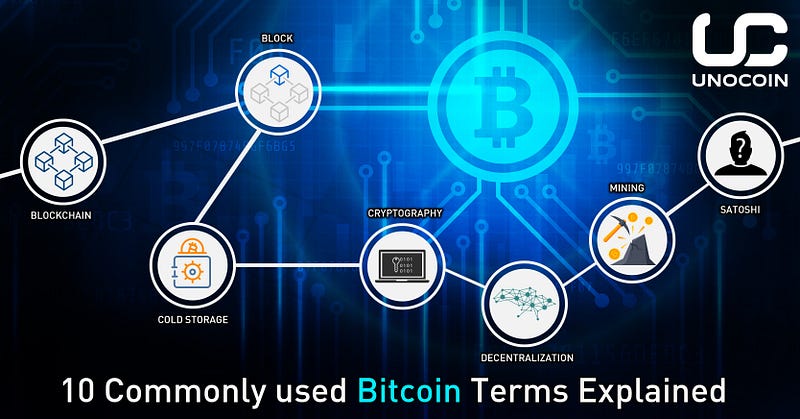
Bitcoin has become, or rather — is, one of the most desired cryptocurrencies today, yet there are people who don’t know it too well. Bitcoin comes with its own set of jargon, which would be useful for you to know even if you’re not intending to trade. Beginners, as well as experts, encounter the same terms, and without knowing them, it would be fairly difficult for someone to understand the currency. Here we list out 10 of the most ordinary ones.
#1 — Blockchain
All the transactions made using bitcoins are registered in a public ledger, which can be viewed by anyone in this world. This public record is called a blockchain — and it’s what made bitcoin so great in the first place! The blockchain contains all the transactions ever made using bitcoin. Hence, the bitcoin technology actually depends on the people, instead of some specific organisation. The global network of all computers involved is responsible for the working of this technology.
#2 — Block
Block is a part of the blockchain. If the blockchain is a notebook, a block would be considered as a page of that notebook. The block records the most recent transactions, and these transactions are verified every 10 minutes through the process we call mining (more on mining, down below).
Therefore, the blocks connect all the transactions together and all the blocks together form a blockchain. The records once were written cannot be altered. This property makes double spending (again, more on this, below) an impossible task.
#3 — Cryptography
According to the basic definitions of cryptography, it is the process or art of making and deciphering codes. Cryptography is the foundation of Bitcoin, which is why it is called a ‘cryptocurrency.’ Bitcoin transactions are anonymous. This happens largely because of cryptography. The information is sent in an encrypted format and it can be decrypted only at the end of the receiver so that no one else is able to see it in the middle. This not only makes the transaction anonymous but also secure. This technology is used in blockchain hash functions, and bitcoin addresses.
#4 — Decentralisation
All of us have heard that bitcoin is a ‘decentralised’ currency. But why? This is because there is no country or organization who owns the bitcoin network. The working of bitcoin is based on a peer to peer protocol. All work is partitioned between the people who own bitcoin. The users need to communicate with each other and send information to each other, instead of approaching an organisation such as a bank.
#5 — Satoshi
Satoshi Nakamoto is the brain behind bitcoin. In 2008, a research paper was posted to a cryptography mailing list. The person or persons who posted it had the username of Satoshi Nakamoto. A peer-to-peer electronic cash system was elaborately defined. It was the first time that the network was secure, efficient, affordable and the problem of double spending had been solved. It was a turning point in the history of cryptocurrencies. Nobody knows who Satoshi is — but we’ve covered suspects extensively in a post here.
Sidenote: A “satoshi” is also the smallest unit of bitcoin — 0.00000001 BTC.
#6 — Mining
The blockchain is checked every ten minutes to confirm transactions. This process is carried out with the help of bitcoin mining. Bitcoin mining involves using a computer to perform mathematical calculations, to check the authenticity of every transaction and to confirm them. Miners are people who are technologically literate enough and possess solid high powered systems to perform this task. Miners are awarded bitcoins for every block of transactions that they verify. Do you think mining is worth it? Read on here.
#7 — Change
This is fairly simple mathematics. Say you head to a store to buy something and pay an amount greater than the price of the object. You will be returned extra money — which is called change. Bitcoin follows the same concept. When the unspent output of a transaction is used as the input in a new transaction, ‘change’ is returned if the amount is higher than required. For example, if you have 5.95 BTC unspent from a previous transaction, and it is used in another transaction that requires 5 BTC, you will receive 0.95 BTC back as change. More on this at the Bitcoin Wiki.
#8 — Private Key
Whenever we use an online payment gateway, we either have a password or a code with the help of which we are able to spend our money, and no one else can. Similarly, in bitcoin, you have a password, using which you can spend the bitcoins from your bitcoin wallet through a cryptographic signature. This password, like any other password, should never be revealed to anyone.
#9 — Cold Storage
With the help of a bitcoin private key, you can securely store your bitcoins in a secure offline environment. It is the reverse of hot storage in which one needs to be connected to the web for all transactions. There are different ways in which bitcoin can be stored in cold storage- for example, a USB drive or some other storage medium, a paper wallet, as physical bitcoins, etc.
#10 — Double Spending
We’ve covered this explanation in our comprehensive ultimate bitcoin guide. Double spending typically means spending the same money twice. Suppose we pay a shopkeeper Rs. 100. Now the shopkeeper owns that money, and we cannot use the same money to buy something else. However, in case of digital currency, our money is in the form of bits, which are much easier to copy and hence double spending is theoretically possible.
Bitcoin is a hit because it prevents double spending, thanks to all the transactions being stored in the blockchain and getting verified by the miners. If you try to double spend, both transactions will be stored in the ledger and after verifying the first one, the miner will declare the second transaction as invalid.
Also Read:
https://blog.unocoin.com/unocoins-stance-on-the-upcoming-segwit2x-fork-6708bf90b1f9
